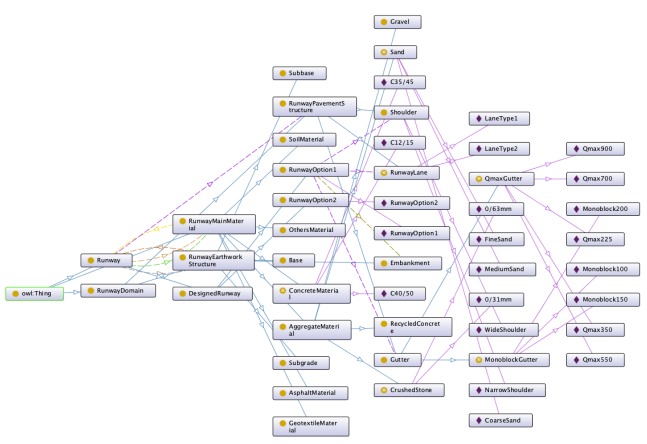Airport Runaway as a Civil System
An airport runway is an essential part of an airport together with aprons, hangars and terminals. A runway can be more precisely defined as a rectangular area that is specially prepared for the landing and takeoff of aircrafts. Runways consist of central lanes and taxiways whose surface can be man-made or natural. Depending on the size and capacity, an airport can have more than one runway. Based on the wind rose of the area where the airport is located runways can be parallel or organized in different directions.
Ontology of an Airport Runaway System
Purpose
The purpose of this ontology is to serve as a system and knowledge representation when planning, modeling, designing and executing runways to a company specialized in design and construction of airports.
Intended Use and Users
Intended use of the ontology is to provide basic knowledge by defining different elements of the system that have to be considered in the early design of runaway. The intended users are staff of the mentioned company, mainly engineers and architects.
Development of the Ontology
The aspects which this ontology is based on are physical components of a runway and major materials that are used in its construction. In this ontology physical components of the runways have been divided in two groups:
1. RunwayEarthworkStructure – which defines the layers below the surface of the runway
2.RunwayPavementStructure – which defines the components above ground that the runways consist of. Based on the components of both classes RunwayEarthworksStructure is divided into subclasses of; embankment, subgrade, subbase and base RunwayPavementStructure is divided into subclasses of; gutter, runwaylane and shoulder The materials used in the process of a runway construction are defined info six subclasses:
-AgregateMaterial
-AsphaltMaterial
-GeotextileMaterial
-SoilMaterial
-OtherMateria
Parametric Model of the Airport Runaway
Design Challenge
When designing civil engineering structures, one must take into consideration many factors like materials, available space, environment, and even the aesthetic aspect. Optimization is key to a successful design and it should not only be focused on the variation of parameters within an existing design but also on the potential alternative systems in general. In order to make the best possible design, with good characteristics, one must work in such an environment that allows fast and easy modification of the initially made design. This environment, besides allowing interactive development and ad-hoc modification should allow visual representation of the model which is pleasing to the human eye and more relatable. Besides the ones mentioned above, cost is one of the driving forces of optimization, and therefore needs to be carefully considered. If there is unlimited funding, less potential problems arise while designing and planning. In reality, funds are limited and this indicates that designers should carefully consider their decisions and try to optimize their design in order lower the costs and stay within budget
High Performance Criteria
-High Capacity
-Low Cost
Logic of the Parametric Design
The most essential parametersthat need to be analyzed in order to fulfill the criteria given by the airport are the length and width of the runway. Length of the runway is defined by the Critical Design Airplane and its Maximum Certified Takeoff Weight (MTOW). Airplane manufacturers provide the necessary information: minimum length of a runway that a specific airplane needs in order to safely take off and land under normal circumstances. A standardized procedure based on this data and the airport’s field elevation and average temperature defines the length of the runway in five steps using tables and graphs provided in. Besides this data, the value range for runway length found in Table 1 is also based on the shortest and longest existing runways. When it comes to runway and shoulder width, maximum and minimum values are given in tables 6-7 and 6-8. These values are given based on the approach type and airplane design group. As for the transversal gradient it is not the same for the runway lane and the shoulders. The shoulders usually have a bigger gradient than the main lane. This gradient is crucial for the proper drainage of the whole construction. The values of runway and shoulder gradients need to be within the given limits provided by ICAO (International Civil Aviation Organization). The specification for gradient values is given in tables 6-10 and 6-11 in. Another notable design parameter is the thickness of asphalt structure. Asphalt is a most common material used for airport runways nowadays. Its thickness is calculated based on maximum load from aircrafts that are going to be using it. The asphalt needs to be carefully executed on site and its thickness correctly calculated. Even if there are local construction errors present, these can seriously endanger the entire structure since the runway as a whole becomes inoperable.
References
Geyer Philipp, (2008) – Multidisciplinary grammars supporting design optimization of buildings
Horonjeff Robert, Francis X. McKelvey, William J. Sproule, Seth B. Young, (2010) – Planning and Design of Airports, Fifth Edition
150/5325-4B – Runway Length Requirements for Airport Design – Office of Airport Planning & Programming, Planning and Environmental Division https://www.faa.gov/airports/resources/advisory_circulars/index.cfm/go/document.cur rent/documentnumber/150_5325-4

